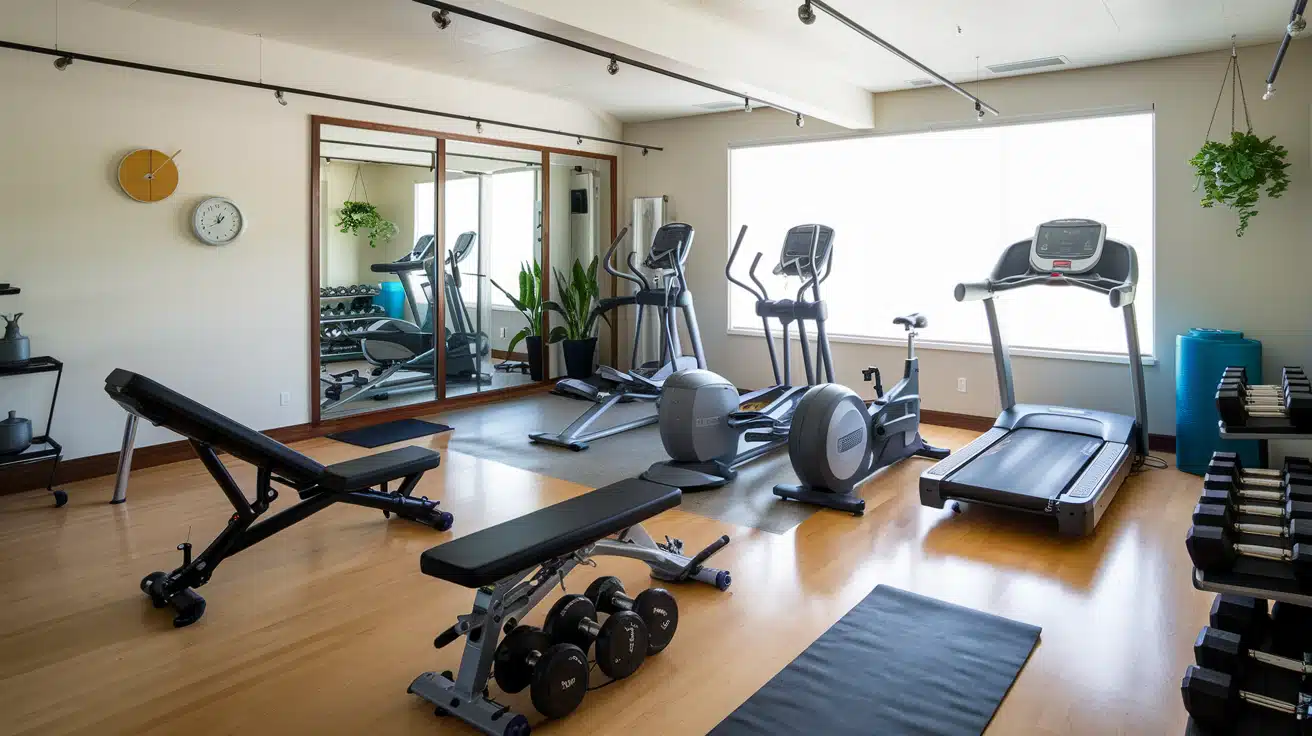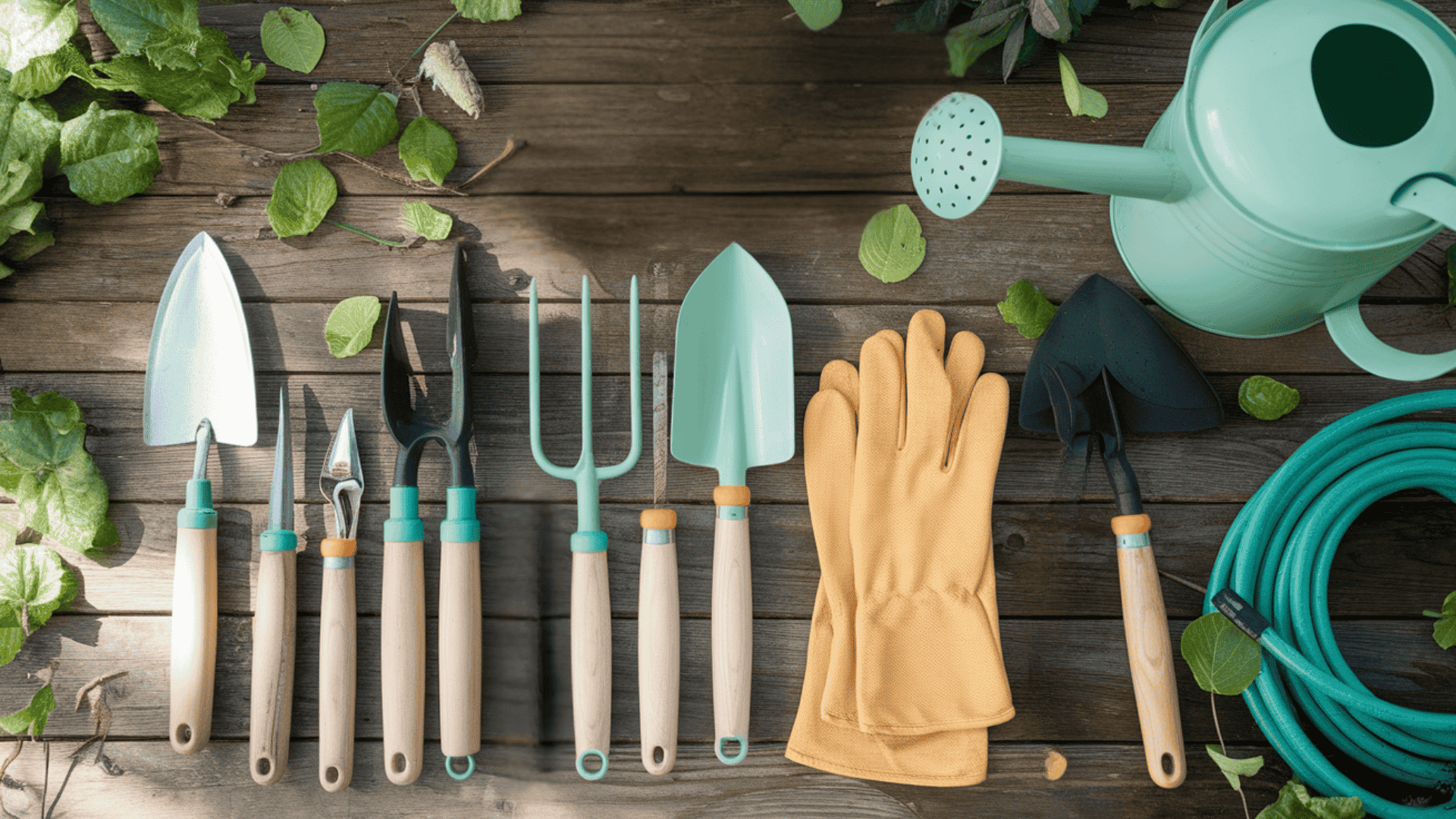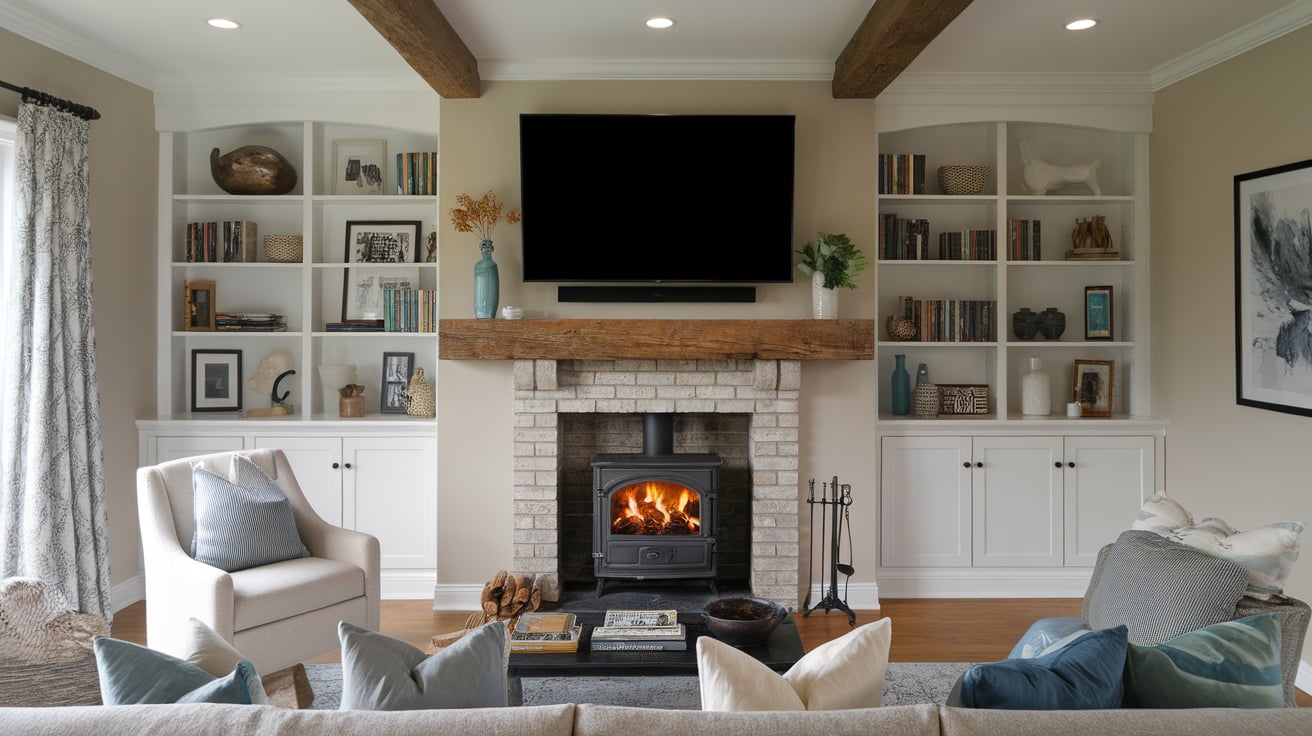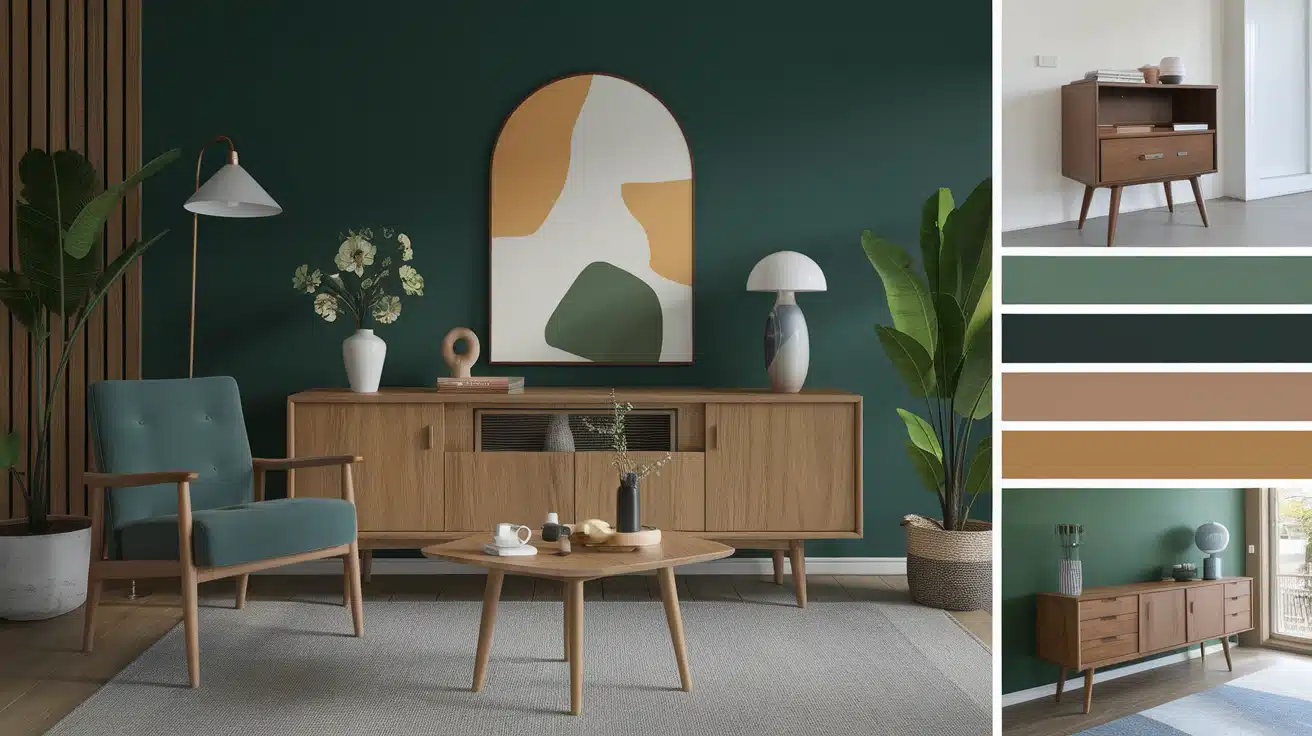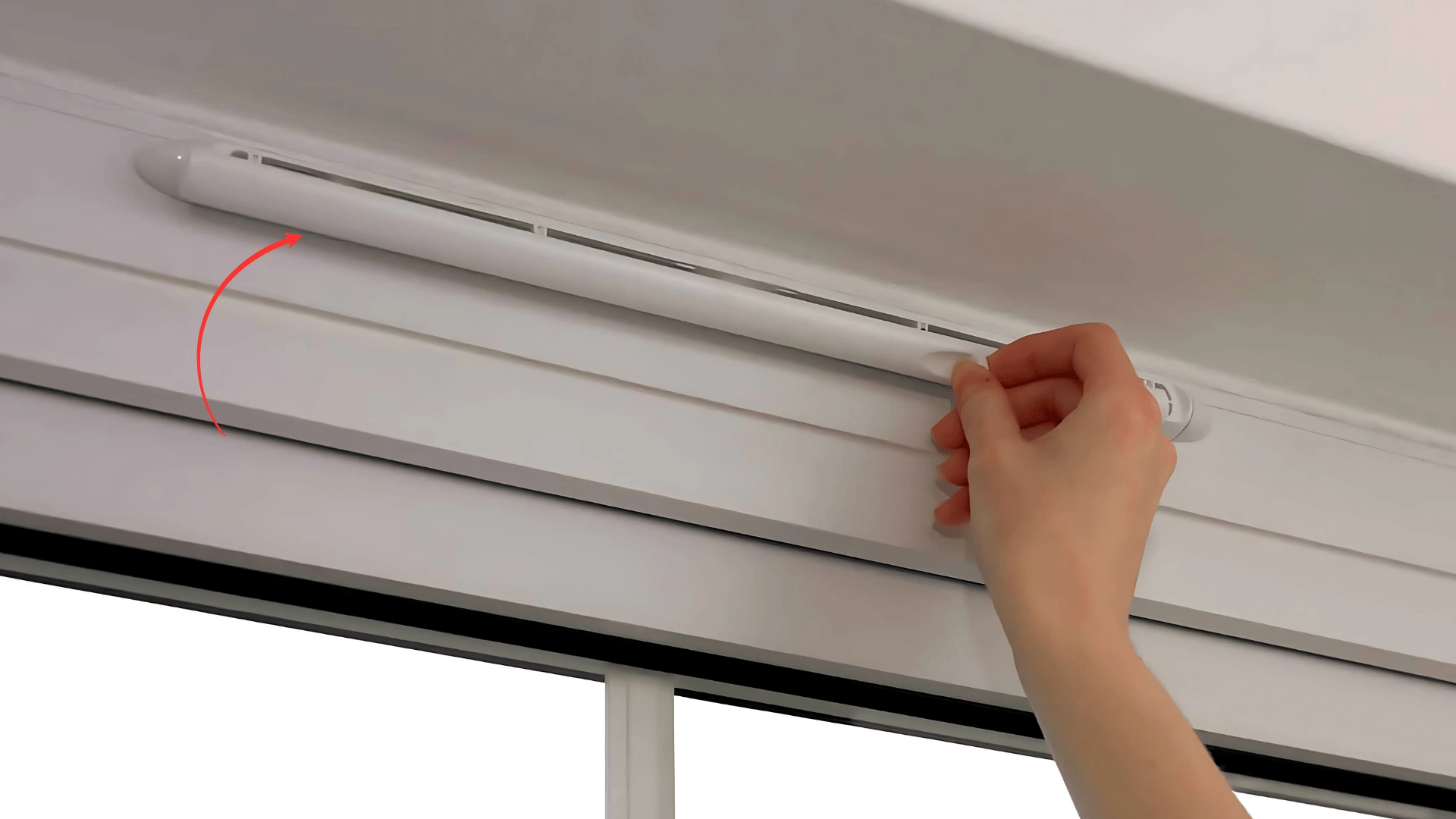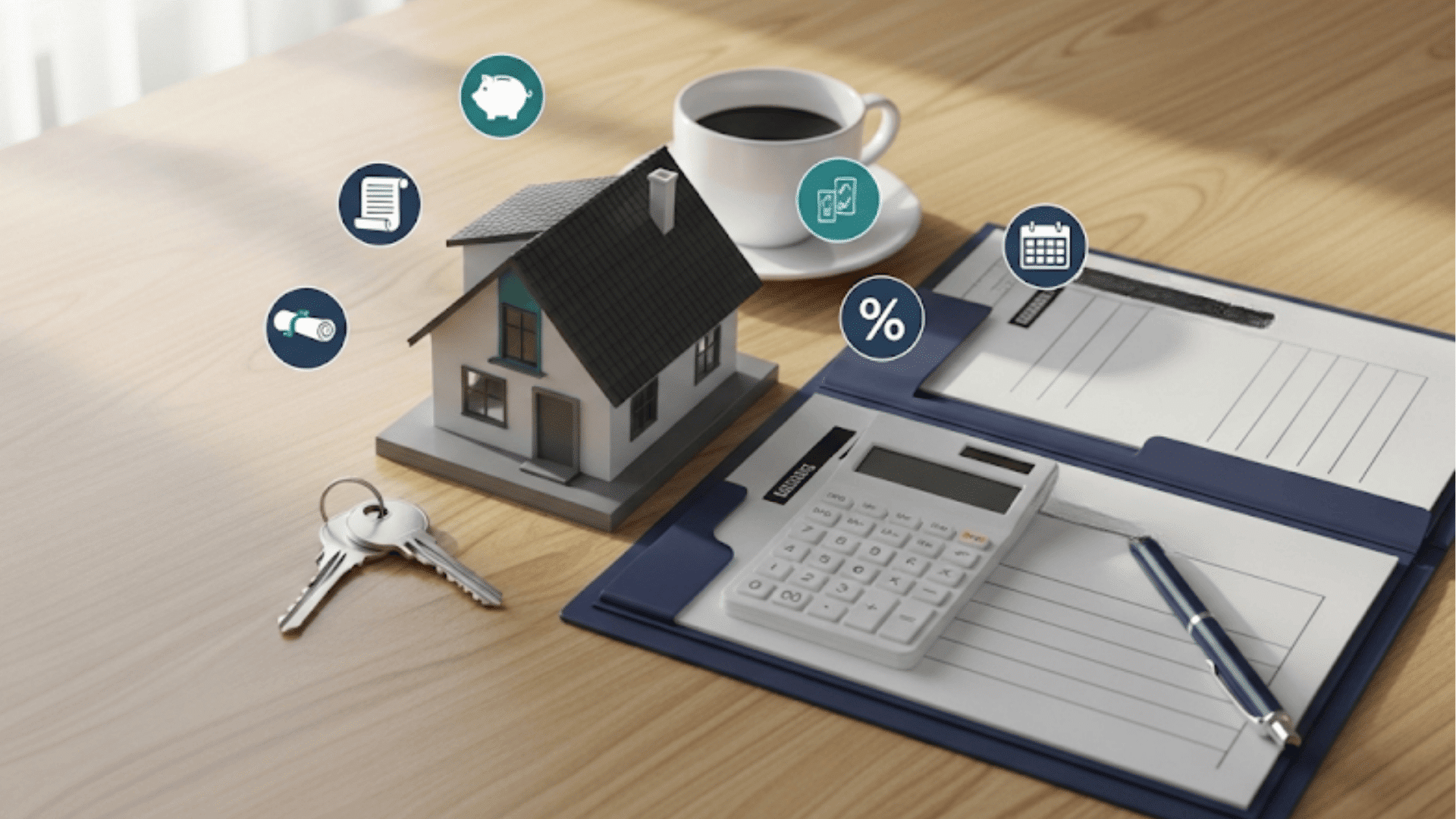Tired of crowded gyms and expensive memberships eating into your budget?
Most people think creating an effective home workout space requires a massive basement or spare room. That’s not true.
Here’s the exciting part: even the smallest apartment can house a fully functional gym that delivers real results. From clever storage solutions to multi-purpose equipment, there are dozens of ways to transform any corner into your fitness haven.
I’m going to show you creative home gym ideas that work in spaces as small as a closet or as large as a garage. These practical solutions will help you build the perfect workout space regardless of your square footage or budget constraints.
Ready to ditch those gym fees for good?
Best Home Gym Ideas for Every Fitness Level
Building a home gym opens doors to convenient, consistent fitness routines that fit any lifestyle or experience level. The secret lies in designing a space that matches specific goals, available room, and budget constraints.
Smart planning creates workout environments that motivate daily exercise habits while providing everything needed for effective training sessions.
- For beginners: starting simple works best with versatile equipment, such as resistance bands, basic dumbbells, and high-quality yoga mats. Focus on establishing a well-lit, motivating area that feels welcoming rather than intimidating. This approach builds confidence while developing fundamental movement patterns and exercise habits.
- For Strength Training: Serious muscle building requires an investment in free weights, kettlebells, or a complete squat rack system. Sturdy, non-slip flooring becomes essential for safety during heavy lifting sessions. Adding an adjustable bench increases exercise variety and supports proper form during various movements.
- For Cardio Enthusiasts: Heart-pumping workouts require dedicated equipment, such as treadmills, stationary bikes, or designated jump rope areas. These cardio options maintain elevated heart rates while fitting into most available spaces. Regular cardio training supports weight management and cardiovascular health goals.
- For Small Spaces: Limited room requires creative solutions, such as multifunctional equipment and wall-mounted storage systems. Adjustable dumbbells and resistance band sets offer comprehensive body workouts without overwhelming compact spaces. Foldable machines maximize functionality while maintaining clean, organized spaces.
23 Home Gym Ideas to Create Your Perfect Workout Space
Find 23 innovative home gym ideas to convert any space into a personalized, functional, and motivating fitness environment for all levels.
1. Build a Standalone Room
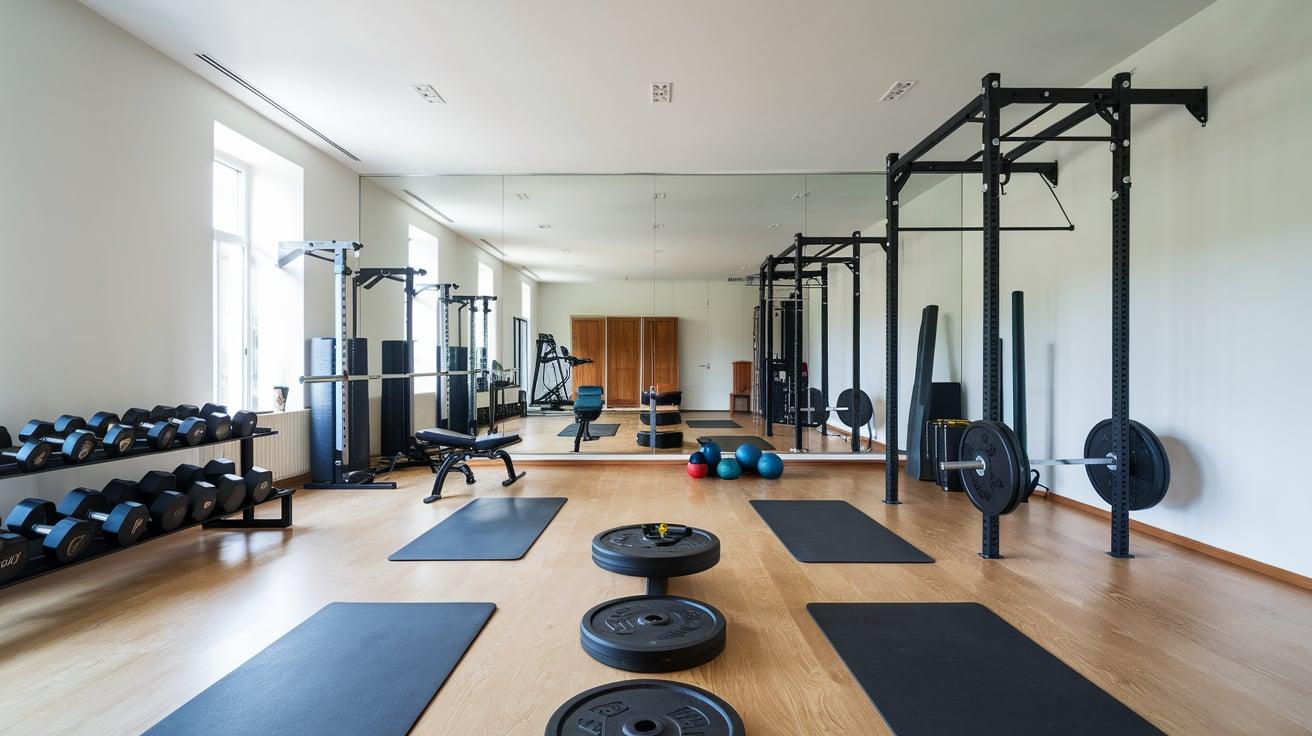
Having a standalone workout room changes everything about fitness routines. Select a spare bedroom, basement area, or garage space that is designated solely as a fitness zone.
This provides privacy to exercise without interruptions from family members or roommates. Music can play loud, equipment stays set up between sessions, and there’s freedom to focus completely on workouts.
A dedicated space helps maintain consistency since the gym remains always ready and accessible for immediate use.
2. Use Natural Materials
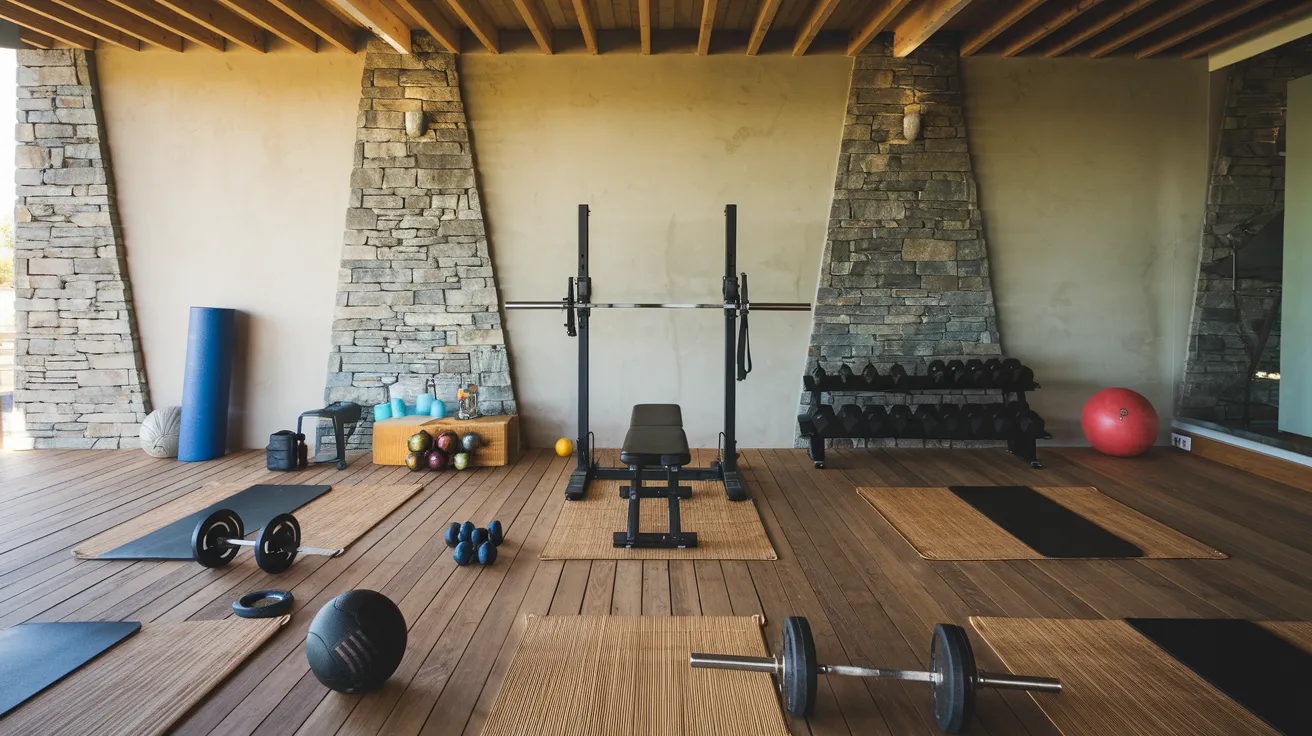
Bringing the outdoors inside by choosing natural materials creates an inviting home gym atmosphere. Wood floors feel warm underfoot and look much better than cold concrete surfaces.
Bamboo mats work perfectly for yoga and stretching areas. Stone accents on walls add texture and transform basement spaces into retreat-like environments. These materials age beautifully, maintain pleasant scents, and establish calming surroundings that make workouts feel more like self-care than chores.
3. Add Open Equipment Storage

Open storage systems are more effective than closed cabinets for organizing a home gym. Wall-mounted racks for dumbbells, resistance bands, and yoga mats keep everything visible and easily accessible.
This setup eliminates excuses about not finding equipment and creates a professional, organized appearance. Open shelving also makes the space feel larger while showcasing fitness gear as motivational decor that encourages regular exercise sessions.
4. Install Large Mirrors
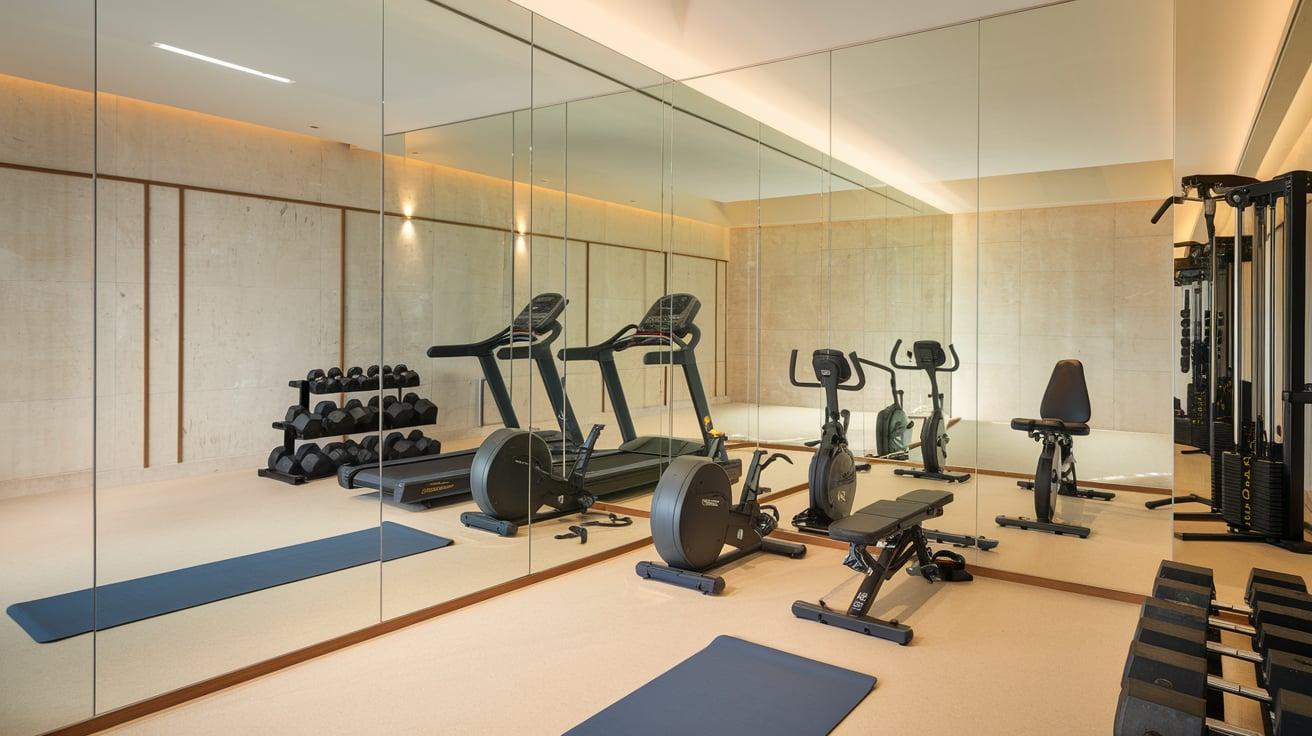
Large mirrors serve multiple purposes in home gym design beyond just checking workout form. They create an illusion of doubled space, making cramped areas feel open and airy.
Mirrors provide immediate feedback on exercise technique, helping prevent injuries and improve results. Strategic placement allows for natural light to flow throughout the room, reducing the need for additional lighting fixtures. Full-length mirrors also boost confidence and motivation during challenging workout sessions.
5. Use Foldable or Multi-Use Equipment
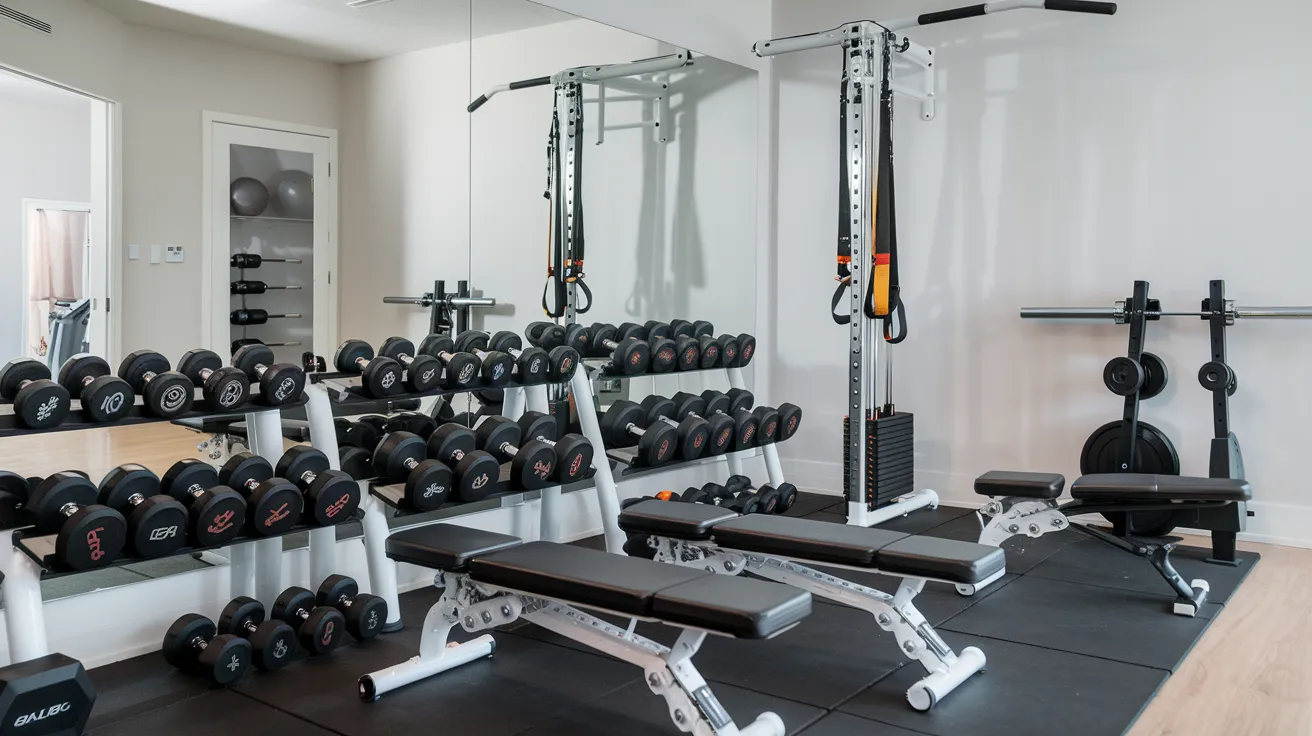
Choosing foldable and multi-purpose equipment maximizes small home gym spaces without sacrificing workout options. Adjustable dumbbells replace entire weight sets, while foldable benches store easily against walls.
Resistance bands provide full-body strength training in a tiny storage box. Multi-use equipment, such as suspension trainers, offers hundreds of exercise variations using minimal space.
This approach keeps costs down while maintaining workout variety and flexibility for different fitness goals.
6. Create a Functional Floor Plan
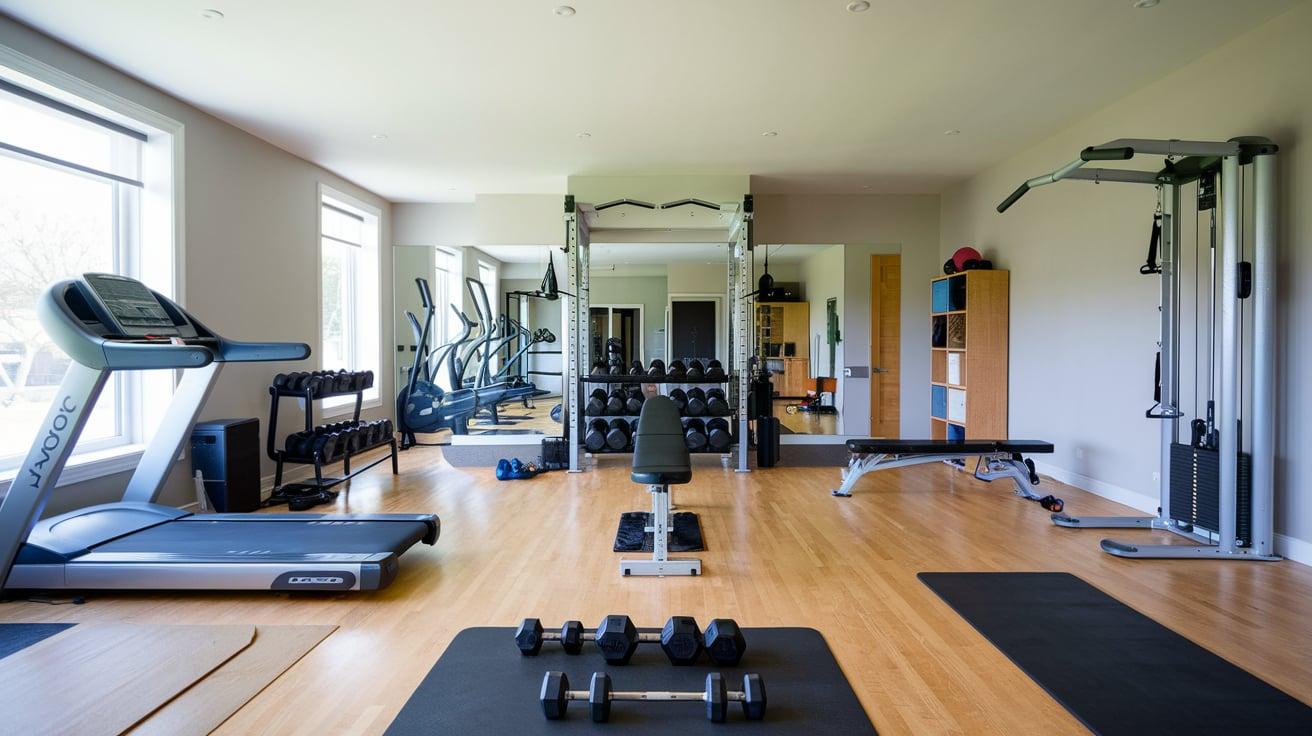
Designing a home gym with distinct zones creates better workout flow and organization. Separate areas for cardio, strength training, and flexibility prevent equipment conflicts and allow smooth transitions between different exercise types.
Place cardio machines near windows for natural ventilation, position strength equipment in the center with adequate clearance, and create a quiet corner for stretching and recovery activities.
This layout approach maximizes space usage while maintaining safety distances between different workout activities.
7. Incorporate Art or Motivational Decor
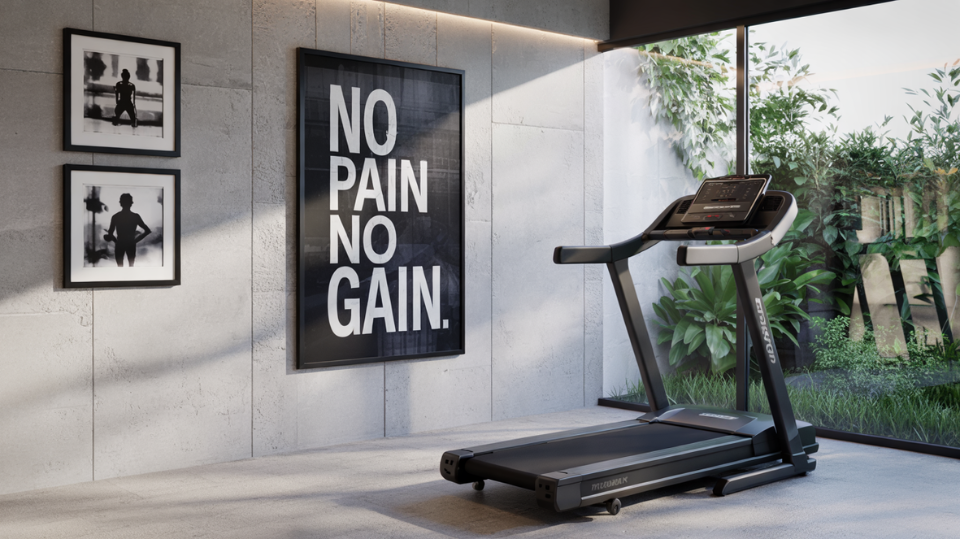
Change your home gym into an inspiring space by carefully selecting artwork and incorporating motivational elements. Hang fitness-themed prints, personal achievement photos, or uplifting quotes that push you through tough workouts.
Visual reminders of goals and past successes boost mental strength during challenging sessions. Select durable, moisture-resistant materials that can withstand the humidity associated with intense training.
Well-placed motivational decor creates positive energy and helps maintain focus throughout every workout routine.
8. Install Rubber Flooring
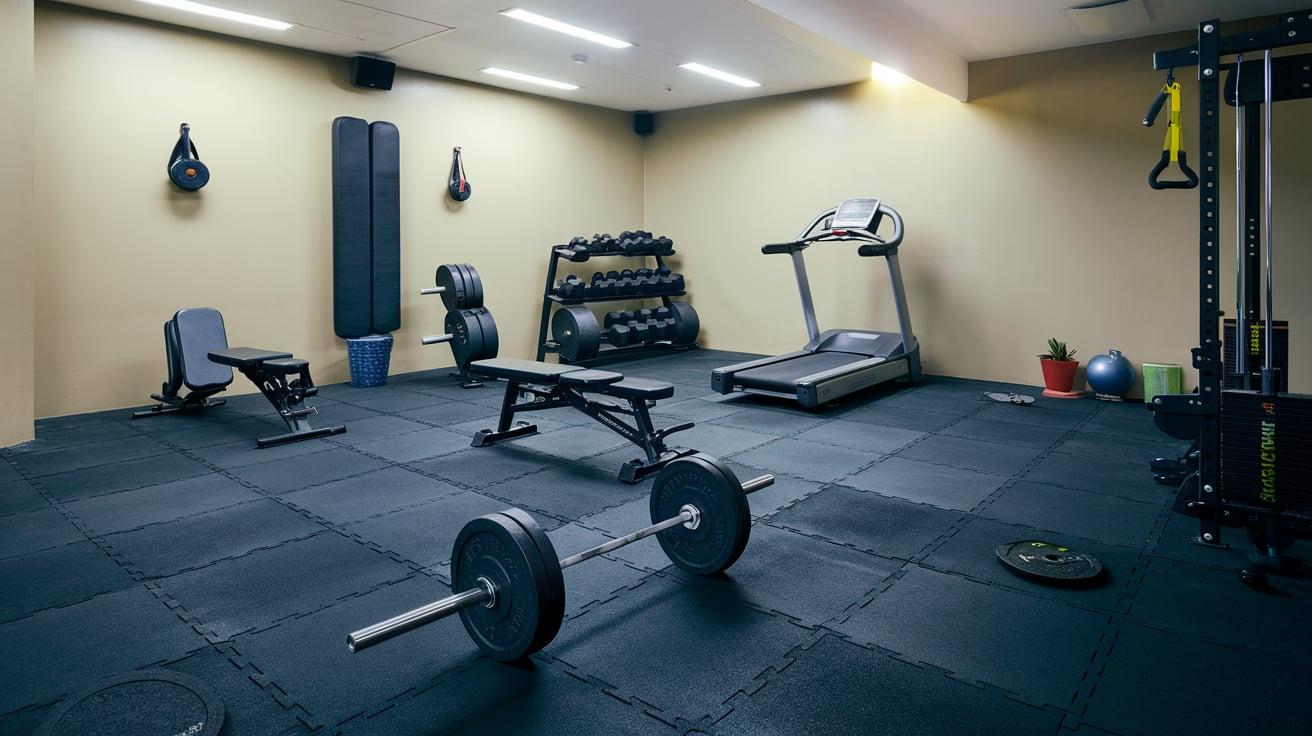
Rubber flooring provides essential protection for both floors and bodies during intense workout sessions. This material absorbs shock from jumping exercises, protects subflooring from heavy weights, and reduces noise transmission to other rooms.
Rubber surfaces offer excellent grip for various exercises while remaining easy to clean and maintain. Interlocking rubber tiles allow for easy installation and replacement if sections become damaged over time.
9. Add Adjustable Lighting
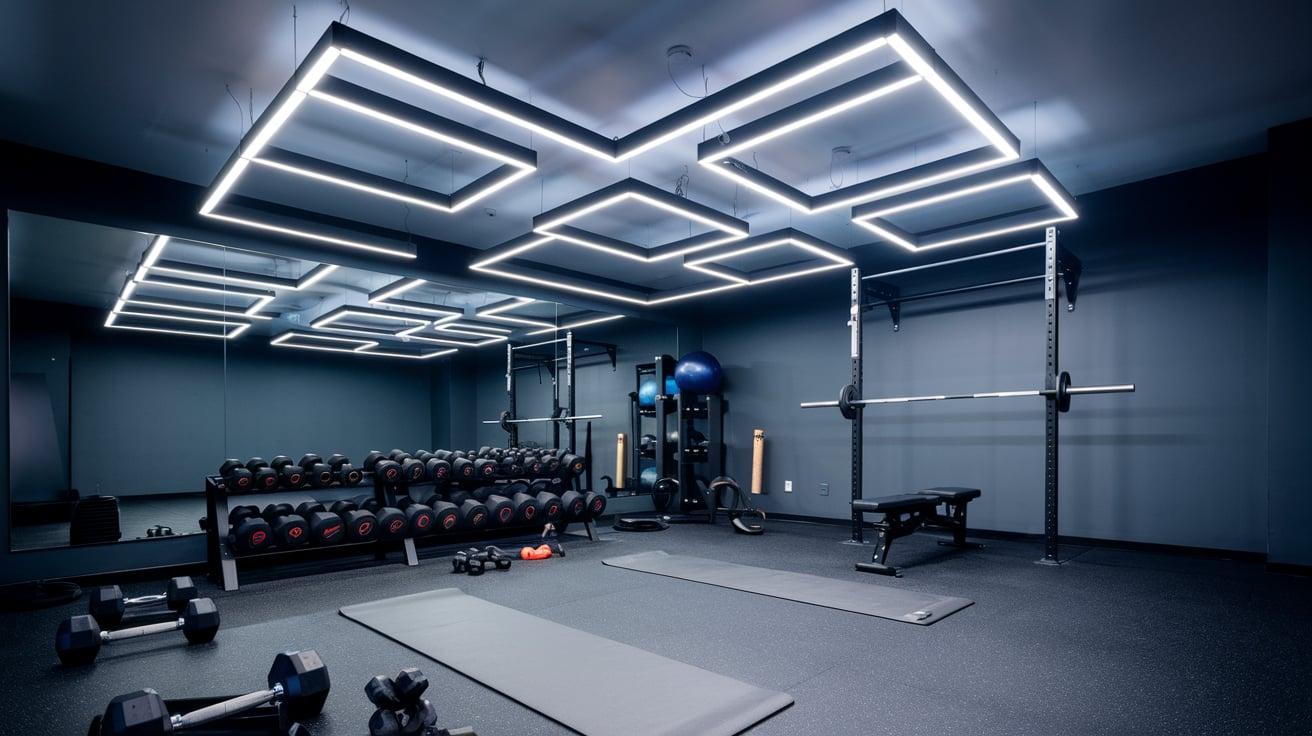
Lighting control transforms any home gym atmosphere to match different workout intensities and moods. Dimmable LED lights provide bright illumination for strength training while offering softer settings for yoga and stretching sessions.
Color-changing options can energize morning workouts with bright white light or wind down evening sessions with warmer tones. Multiple light sources eliminate shadows and create even illumination throughout the entire workout space.
10. Include a Stretching and Recovery Zone

Setting aside specific space for recovery activities supports better fitness results and injury prevention. This quiet corner should accommodate foam rollers, yoga mats, massage balls, and stretching straps.
Soft flooring materials, such as thick mats or carpet tiles, create a comfortable surface for floor exercises. Keep this area separate from high-intensity zones to maintain a calm atmosphere that encourages proper cool-down routines and flexibility work.
11. Make Use of Garage Space
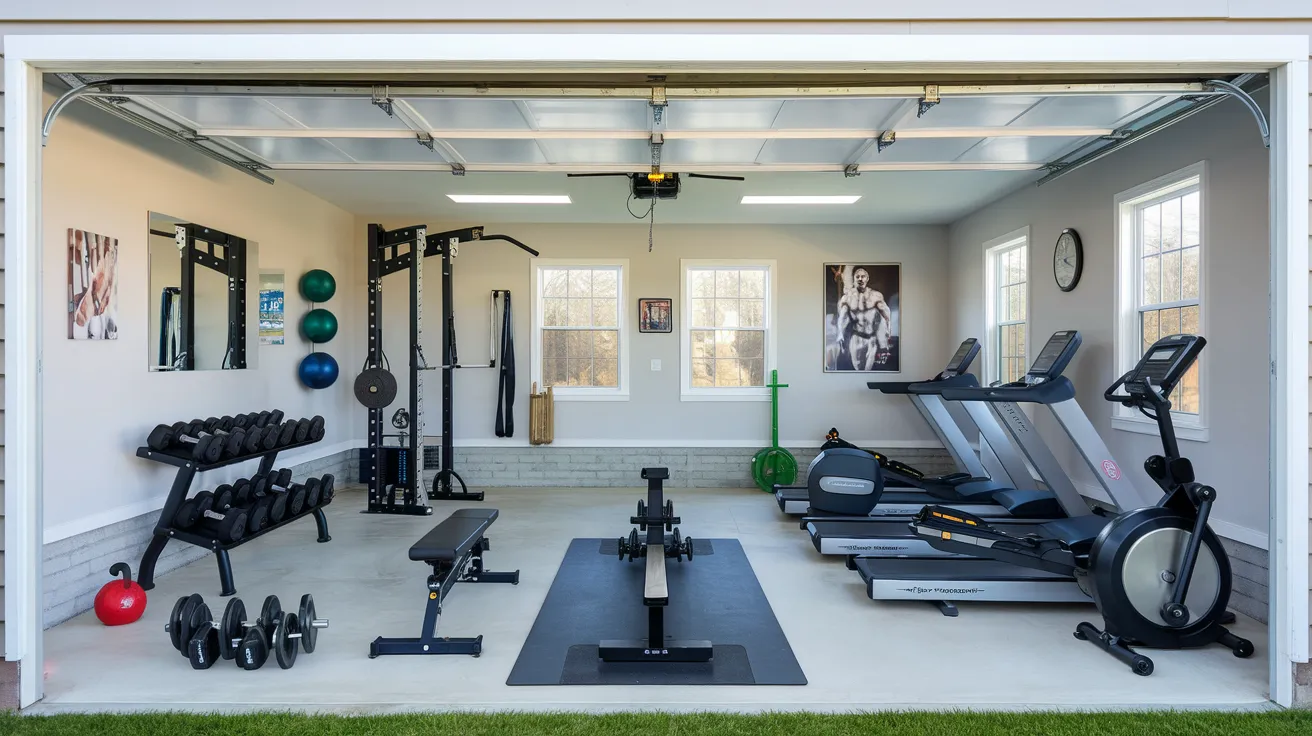
Converting garage space into a functional gym provides maximum room for equipment and movement. Install insulation and climate control to maintain comfortable temperatures throughout all seasons.
Choose equipment with wheels or compact designs for easy storage when vehicles need a parking space. Concrete floors work well with rubber mats, while overhead storage effectively utilizes vertical space. Garage doors provide excellent ventilation during intense workout sessions.
12. Create a Cardio Corner
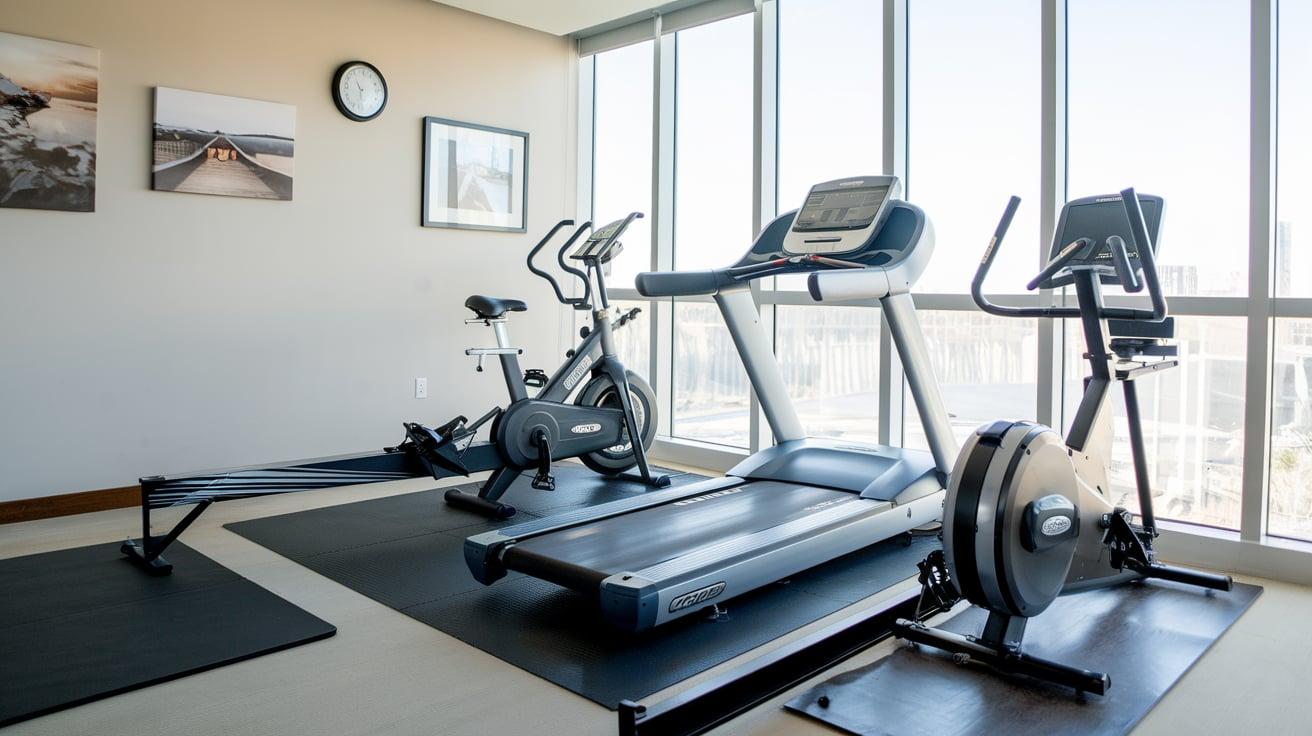
Setting up a dedicated cardio area keeps heart-pumping equipment organized in one convenient location. Choose from treadmills, rowing machines, or stationary bikes based on available space and fitness preferences.
Position cardio machines near windows or fans for better airflow during intense sessions. This focused setup enables quick transitions between different cardio exercises, while keeping the rest of the gym available for strength training and flexibility work.
13. Use Vinyl Flooring

Vinyl flooring offers excellent durability and comfort for home gyms at budget-friendly prices. Modern luxury vinyl planks resist moisture, scratches, and damage from heavy equipment while providing cushioned support for joints during floor exercises.
Easy installation makes this a perfect DIY project for most homeowners. Vinyl surfaces clean quickly with simple mopping and maintain their appearance for years, even through intense workouts. This flooring choice combines practical benefits with attractive wood or stone-look designs.
14. Use a Minimalist Design
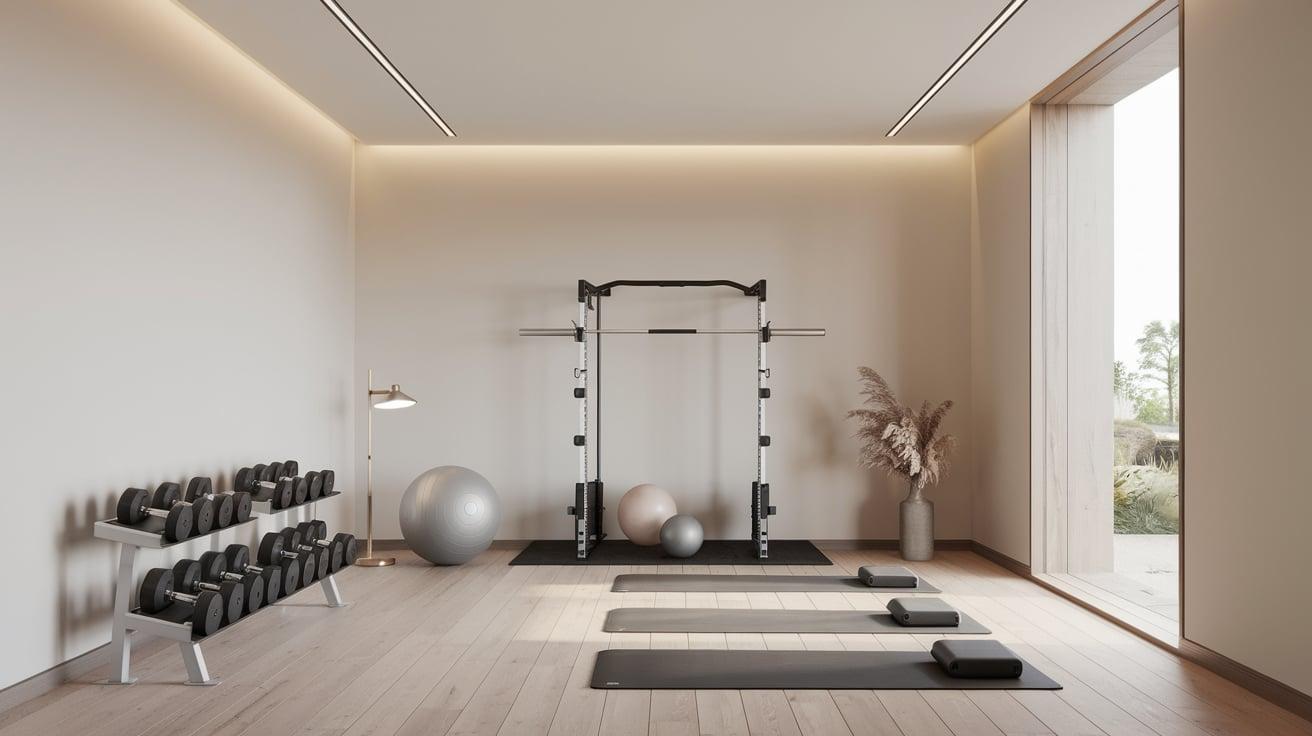
Simple design approaches create calming workout environments that reduce distractions and improve focus. Neutral colors like white, gray, and beige make spaces feel larger and more inviting.
Limited equipment selection forces concentration on proven, effective tools rather than collecting unused gadgets. Clean lines and uncluttered surfaces promote mental clarity during exercise sessions while making cleaning and maintenance much easier.
15. Add a Yoga or Meditation Area
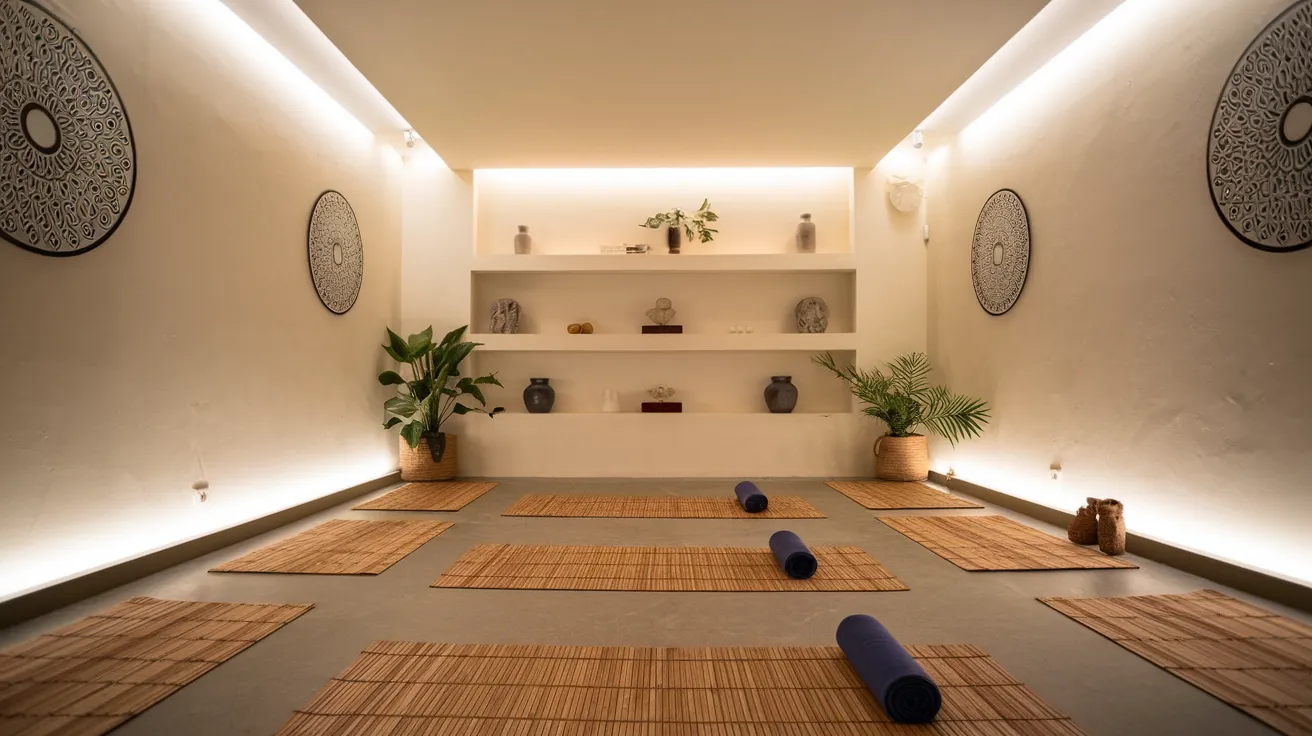
Creating a peaceful zone for mindfulness practices supports both physical and mental wellness goals. This quiet corner needs soft lighting, comfortable flooring, and minimal visual distractions.
Natural materials like bamboo mats and wooden props enhance the calming atmosphere. Keep this space separate from high-energy workout areas to maintain tranquility during meditation, stretching, and breathing exercises.
16. Install a Sound System
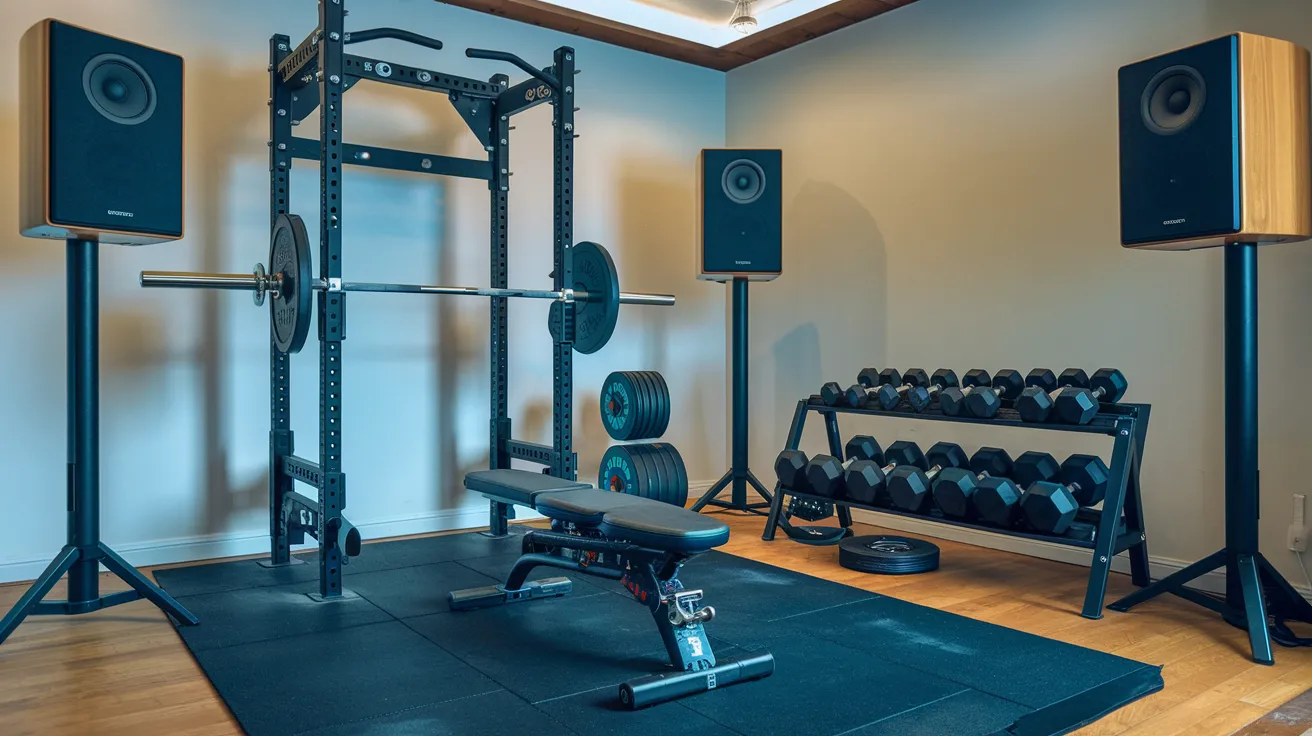
Quality audio equipment transforms home workouts from boring routines into energizing experiences. Wireless speakers eliminate cord clutter while providing clear sound throughout the entire space.
Bluetooth connectivity allows easy streaming of music playlists, guided workouts, or virtual fitness classes. Good speakers motivate harder training sessions and make solo workouts feel more engaging and fun.
17. Use Multifunctional Furniture
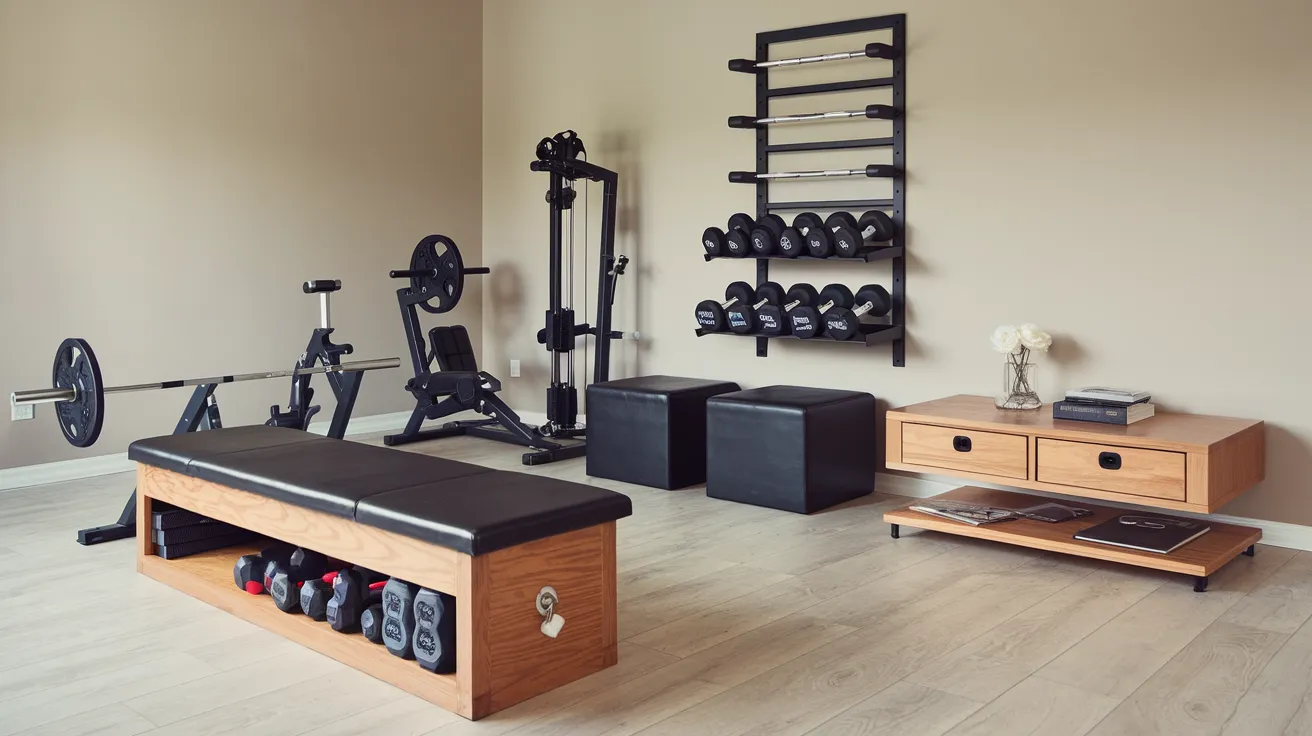
Furniture pieces that serve multiple purposes maximize efficiency in compact home gyms. Storage benches provide seating for exercises while hiding equipment inside.
Ottoman units offer leg elevation for stretches and concealed storage for smaller accessories. Convertible pieces adapt to different workout needs throughout the day, maintaining organized and clutter-free spaces.
18. Add a Sauna or Steam Room
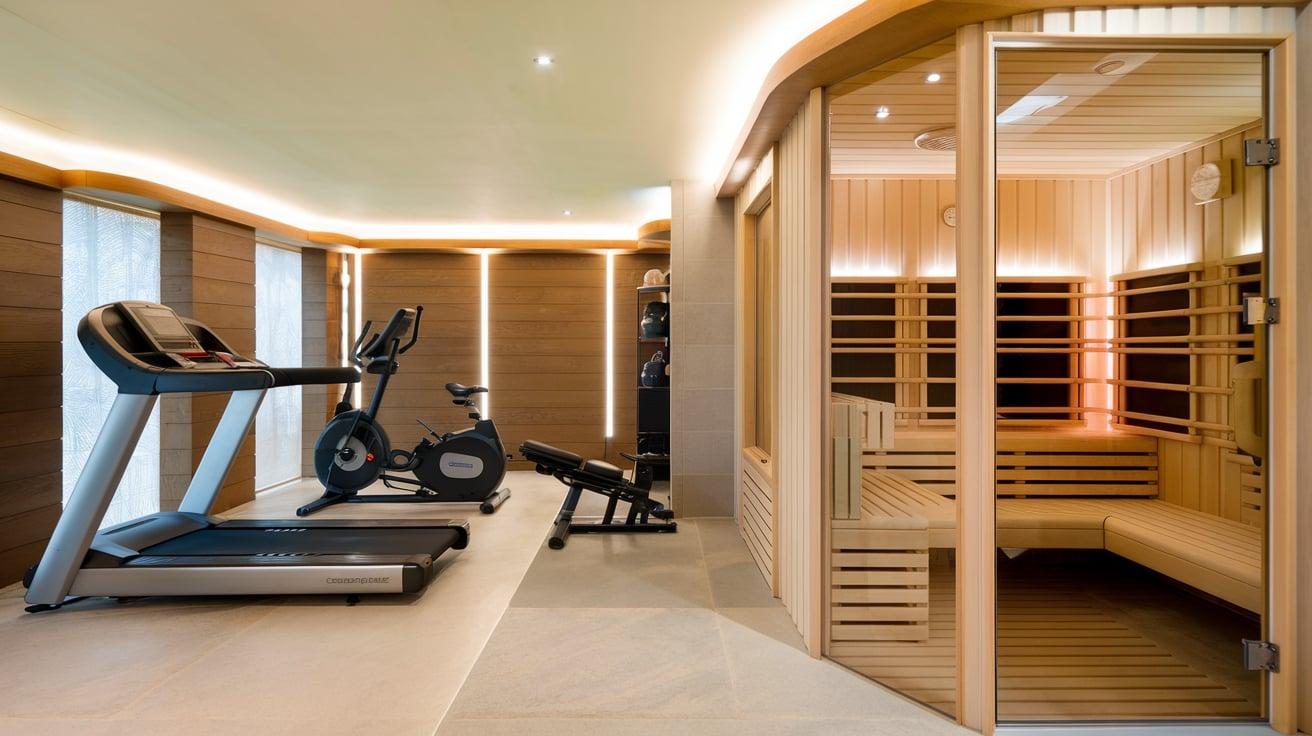
Heat therapy additions offer professional spa experiences right at home, providing ultimate post-workout recovery. Small infrared saunas fit into compact spaces while offering significant health benefits.
Steam rooms help muscles relax after intense training sessions. These luxury features increase property value while supporting faster recovery times and improved sleep quality.
19. Incorporate Outdoor Elements
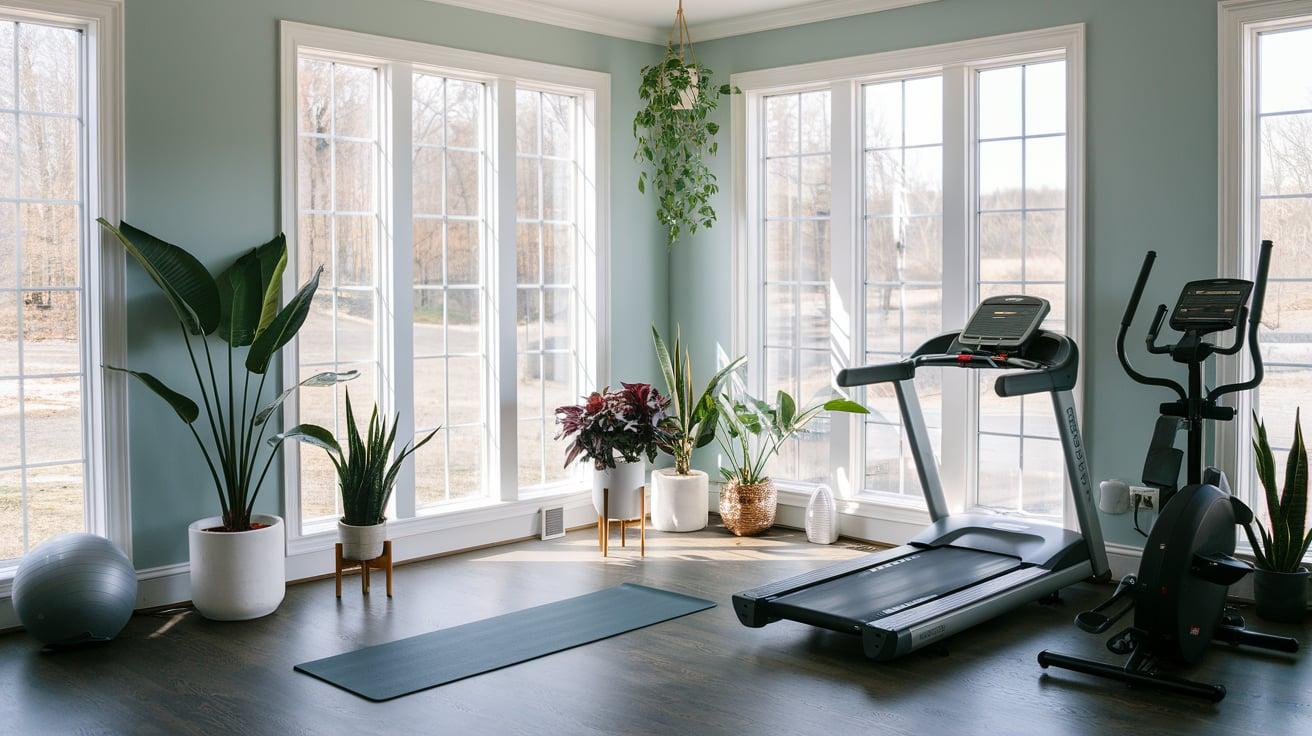
Natural elements create refreshing workout environments that feel less confined than typical indoor gyms. Indoor plants not only improve air quality but also add visual appeal to sterile spaces.
Large windows provide natural light and outdoor views during exercise sessions. Some homes feature outdoor workout areas that capitalize on fresh air and natural surroundings.
20. Design a Boxing or Kickboxing Area
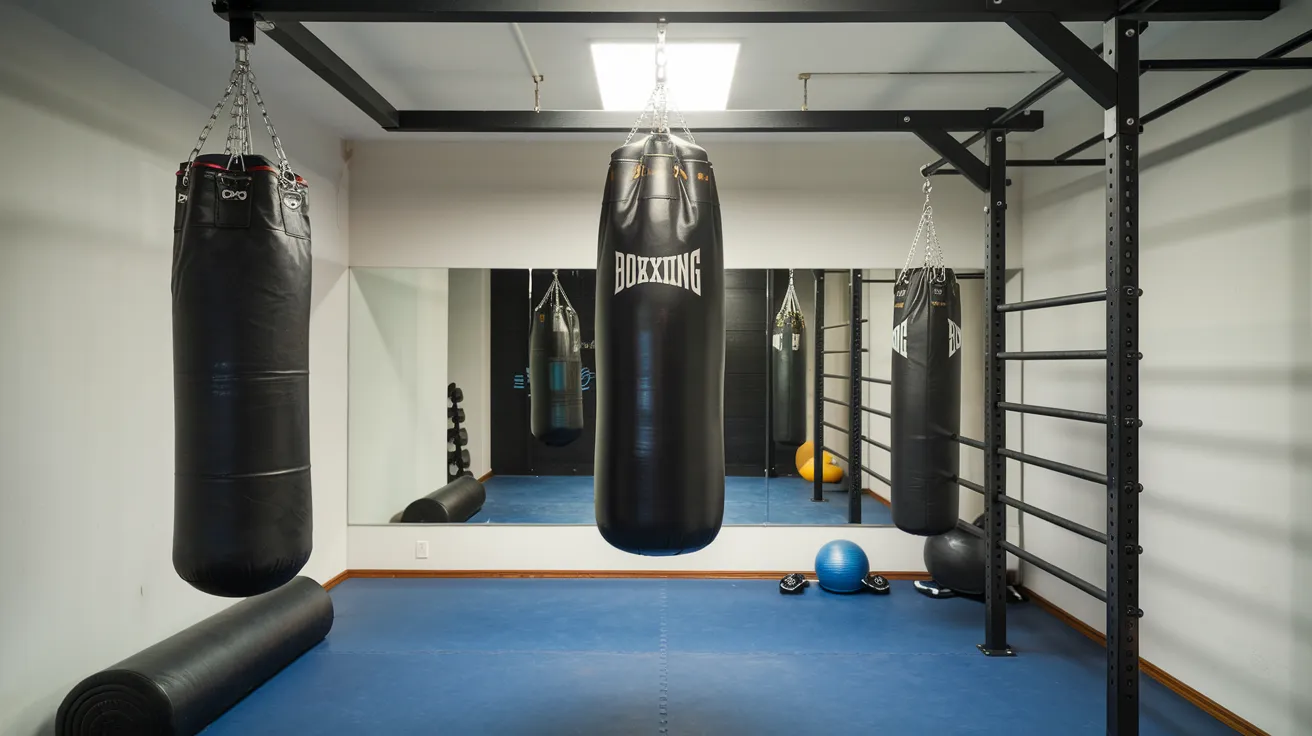
Boxing and kickboxing areas bring high-intensity cardio training into home gym spaces through dedicated striking zones. Heavy bags provide resistance training for punches and kicks while building core strength and improving coordination. Speed bags develop hand-eye coordination and timing skills essential for boxing techniques.
Clear floor space around equipment allows for shadowboxing, footwork drills, and movement patterns. Proper ceiling height and secure mounting become crucial for hanging bags safely. This setup offers stress relief benefits alongside physical conditioning while requiring relatively minimal equipment investment compared to other fitness options.
21. Create a Family-Friendly Space
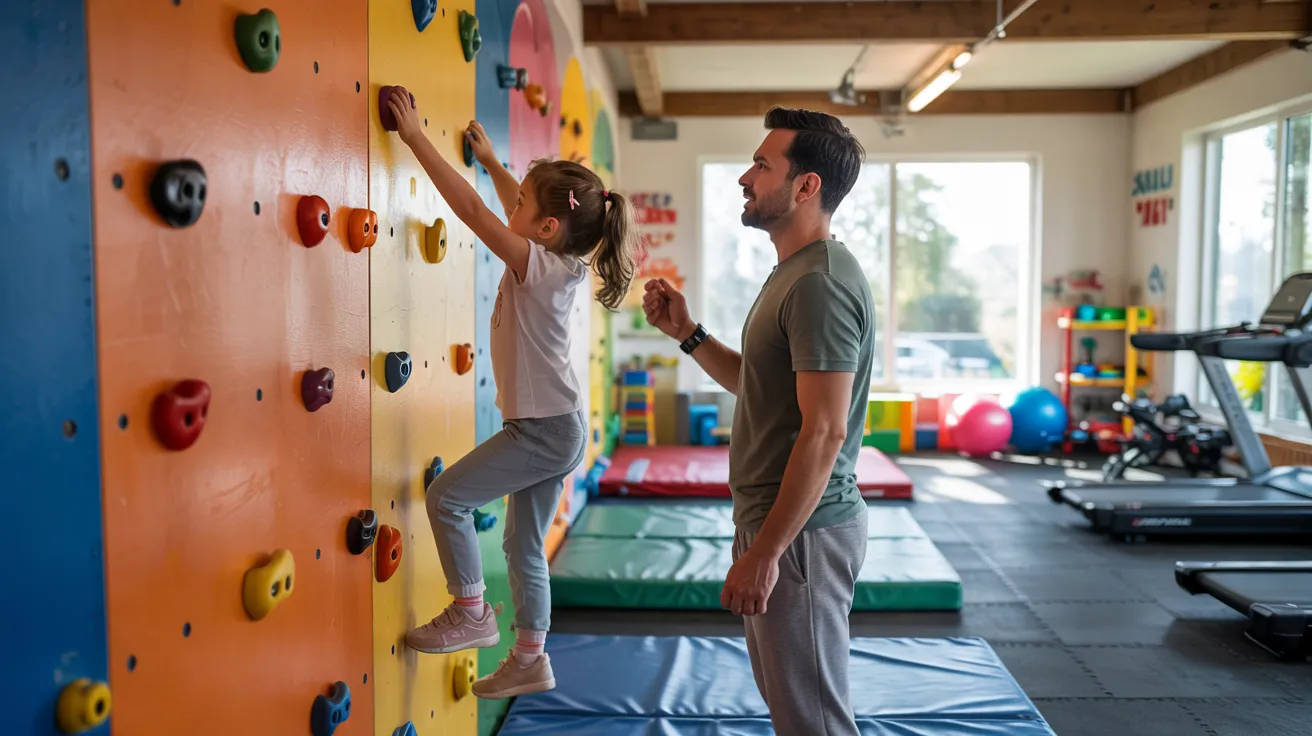
Designing a section for children encourages active family time while adults complete their workout routines. Install lower pull-up bars, soft play mats, and lightweight equipment sized for smaller hands.
This area keeps kids engaged with simple exercises, such as jumping jacks, stretching, or balance games. Family workout time helps build healthy habits early, allowing parents to maintain their fitness routines without childcare concerns.
22. Create a Multi-Functional Workout Station
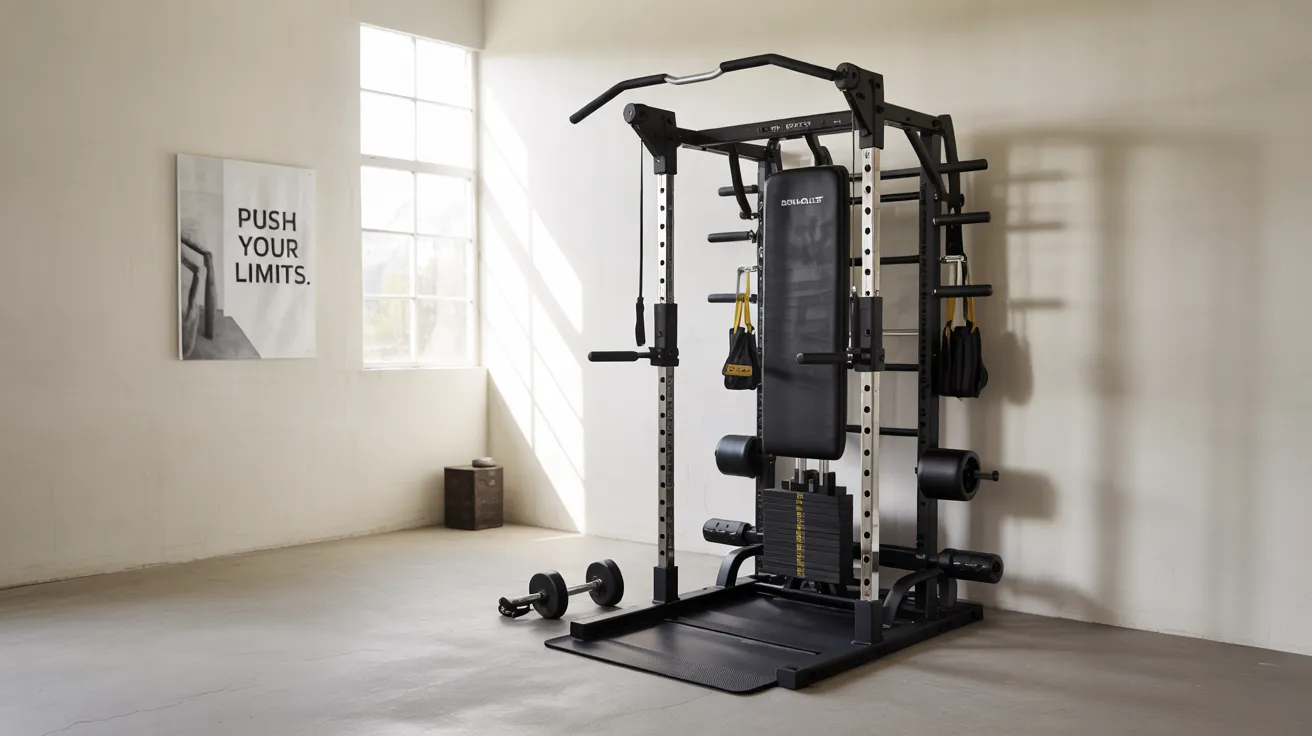
Multi-functional workout stations combine several exercise tools into a compact unit, saving both space and money. These stations typically combine pull-up bars, dip stations, push-up handles, and attachment points for resistance bands or suspension trainers.
The all-in-one design eliminates the need for multiple separate pieces of equipment while providing complete upper body and core training options.
Most stations require minimal floor space and can fit into corners or against walls when not in use. Quality models accommodate a range of body weights and heights, making them suitable for various family members with differing fitness levels.
23. Create a Smart Gym
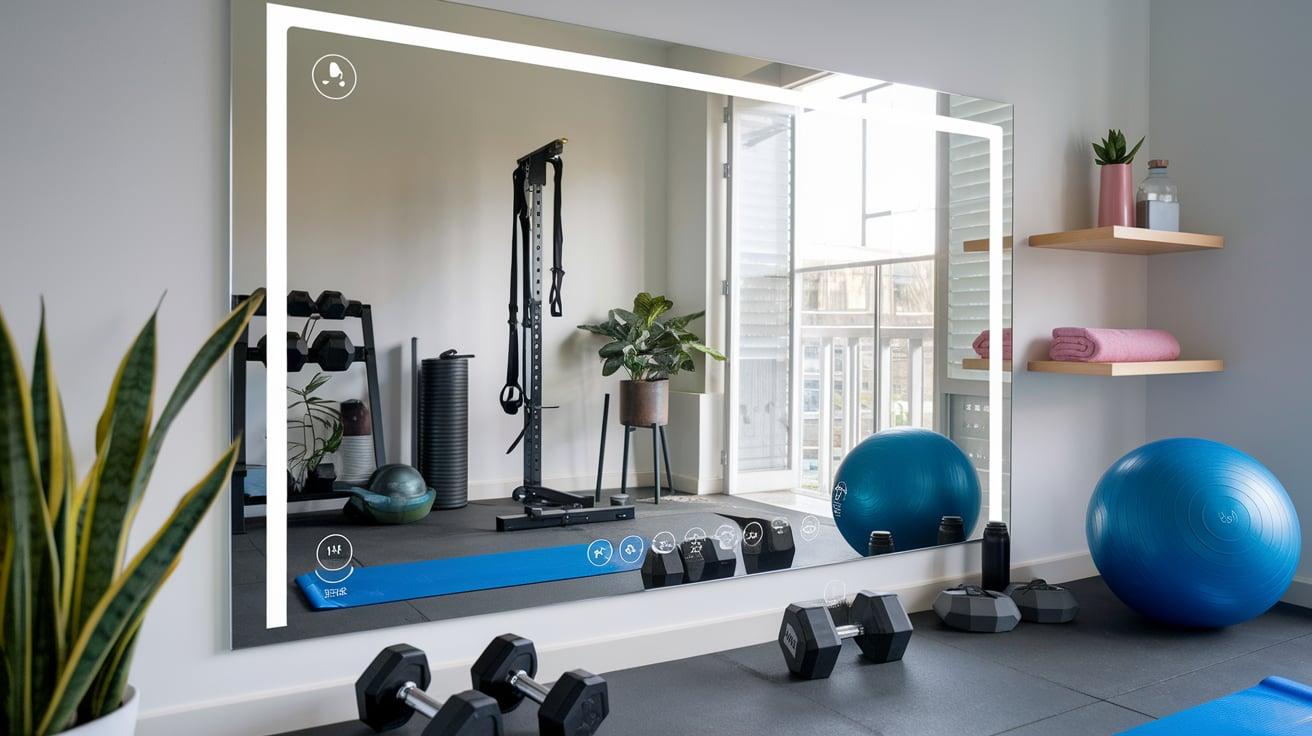
Technology integration changes basic home gyms into interactive fitness experiences that rival premium facilities. Smart mirrors provide real-time form feedback and access to thousands of guided workout classes.
Fitness trackers monitor heart rate, calories burned, and workout intensity throughout each session. Connected apps sync progress data across devices while offering personalized training programs that adapt to individual fitness levels and goals.
Summary Table: Home Gym Solutions by Need
Here’s a quick-reference guide to help match your fitness goals with the best home gym ideas based on your space, style, and priorities.
| Need | Best Idea(s) |
|---|---|
| Small space | Foldable equipment, vertical storage |
| Strength training | Squat rack, rubber flooring |
| Recovery | Stretching zone, sauna |
| Budget setup | Resistance bands, bodyweight stations |
| Cardio focus | Cardio corner, jump rope space, compact machines |
| Mind-body wellness | Yoga/meditation area, natural lighting, bamboo mats |
Building your ideal workout space is less about square footage and more about smart planning, consistent habits, and a setup that energizes you.
Final Thoughts
Creating the perfect home gym doesn’t require a mansion or thousands of dollars in equipment. These creative home gym ideas demonstrate that any space can be converted into a functional fitness zone with thoughtful planning and the right approach.
The real magic happens when fitness becomes an integral part of daily life, rather than a distant goal. Home gyms eliminate excuses like bad weather, crowded facilities, or inconvenient hours. More importantly, they create a personal space where consistency thrives.
Start small with one or two ideas that fit both space and budget. Build gradually as fitness habits develop. Remember, the best home gym is the one that gets used regularly.
Which creative home gym idea will change the way fitness fits into daily routines?
Pick one, start today, and watch how convenient workouts change everything about staying active.
Frequently Asked Questions
Is It Cheaper to Build a Home Gym?
Yes, building a home gym can save money in the long term. Initial equipment costs range from $500 to $3000, while gym memberships cost over $ 600 yearly. Home gyms pay for themselves within 2-3 years.
What Type of Flooring Is Best for A Home Gym?
Rubber flooring works best for home gyms. It absorbs shock, reduces noise, protects floors from weights, and provides excellent grip for all exercise types.
Are Rolls Better than Tiles for Gym Flooring?
Rubber rolls create seamless surfaces with fewer gaps, making them less prone to dirt accumulation. Tiles offer easier installation and replacement of damaged sections. Choose rolls for larger spaces, tiles for smaller areas.
